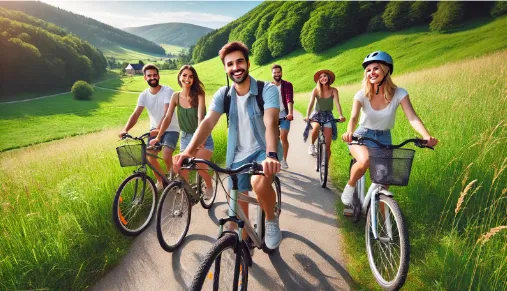
Bike Rides for the Whole Family: An Activity for All Ages
Admin
August 8, 2024
721 words
3 minutes
If there’s something fun that brings kids and adults together, it’s undoubtedly a bike ride.
The connection between the bicycle and the family begins at an early age, when most of us start pedaling under the guidance of our father or mother. After balance became the dominant feature, there followed rides by the sea or through springtime nature, picnics and adventures powered by two wheels that have left us with lifelong memories.
However, in order for your bike ride to go smoothly and for there to be no falls, you need to prepare for it by paying particular attention to the factors that we’re going to tell you about in this article by Top Bike Tours.
How to prepare a Family Bike Ride?
The first step in preparing for a family bike ride has to do with logistical issues, more specifically the place best suited to the abilities of each member of the family and the objectives of the ride.
Choose the Perfect Place for the Tour
The choice of location for a family bike ride should take into account the physical fitness and age of the “cyclotourists”, the type of bike chosen and the objectives of the ride.
So, if you’re taking a child and/or elderly person on the tour, it’s important that the route is as uneven as possible and that you make sure that there are shady spots along the way and water supplies, for example.
You should also pay attention to the weather conditions, as areas more exposed to the wind condition the ride and can turn it into a bit of a mountain count, especially if it’s blowing from the front.
As for the route to follow, consider passing by historical and natural monuments that make the ride more interesting from an educational point of view. A good solution in this case is to bet on the ecotrails and cycle paths that exist throughout the country.
If you prefer a more sporty ride, choose a mountain route, but be careful not to stray off the recommended trails.
To make your choice easier, you can always contact us and sign up for one of the many interesting tours that Top Bike Tours Portugal has in store for you.
Among these Portugal cycling tours, we highlight the “easy difficulty level” routes for all ages that take us from Porto to Santiago de Compostela along the coast, the Costa Vicentina where you’ll be exposed to the natural beauty of the Alentejo coastline and the Douro Valley Wine, a tour where you can not only be in direct contact with Port wine estates and producers, but also visit cities and monuments that mark the history of Portugal and even of Humanity itself.
Prepare the equipment
Once you’ve chosen your route, more technical preparations come into play, such as preparing your equipment and choosing your bikes.
As far as equipment is concerned, safety should be your top priority, so don’t forget to pack it:
- Helmet, knee pads (especially for the little ones), cycling gloves and suitable cycling shoes (cycling shoes for road bikes, comfortable sneakers for mountain bikes or walking bikes);
- Water jugs or bottles (even on a quiet family walk, hydration is essential!);
- A light, waterproof and ergonomic backpack that weighs no more than 10% of your body weight. In it, you should take fruit, energy bars, a first aid kit and a cell phone;
- Light clothing suitable for sports and the time of year.
- A good mood.
When it comes to bikes, it’s important that they are not only suitable for the size and physical condition of each member of the family, but also for the terrain you’ll be riding on.
In this sense, if you’re going for a family ride on a bike path, we recommend using a touring bike, but if the route is rougher or mostly on trails, a mountain bike is the best choice.
You could also opt for an electric bike, which can be used by the whole family and on any type of terrain.
What to do during the tour?
If there’s one thing that Top Bike Tours and Top Walking Tours in Portugal have in common, it’s the wide variety of points of interest and off-bike activities they offer the whole family.
As we mentioned, to make the bike tour family-friendly, choose routes that pass by historical monuments/places with history. Do your best to visit them and try to understand or explain their origins.
You can and should also stop to admire the scenery and take advantage of these moments to have a picnic.
If you’re not taking a picnic, these walks can also help you get in touch with the gastronomy and traditions of the region you’re visiting.